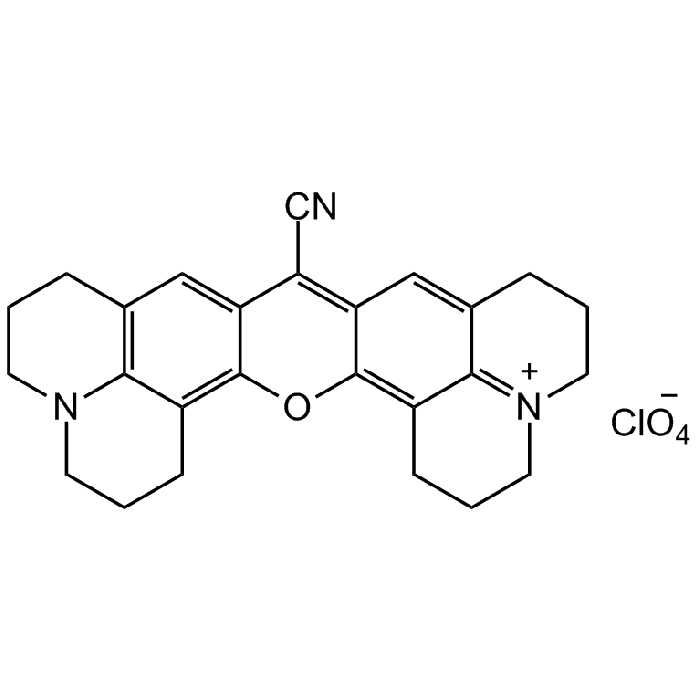Cookie Policy: This site uses cookies to improve your experience. You can find out more about our use of cookies in our Privacy Policy. By continuing to browse this site you agree to our use of cookies.
Chemodex
Rhodamine 800

| Product Details | |
|---|---|
| Product Type | Chemical |
| Properties | |
| Formula | C26H26ClN3O5 |
| MW | 495.95 |
| CAS | 137993-41-0 |
| Source/Host Chemicals | Synthetic |
| Purity Chemicals | ≥95% (HPLC) |
| Appearance | Dark purple to black powder. |
| Solubility | Soluble in ethanol, methanol or DMSO (20mg/ml). |
| Identity | Determined by 1H-NMR. |
| Declaration | Manufactured by Chemodex. |
| Other Product Data |
Click here for Original Manufacturer Product Datasheet |
| InChi Key | HACOCUMLBPNDIN-UHFFFAOYSA-M |
| Smiles | [O-]Cl(=O)(=O)=O.N#CC1=C2C=C3CCC[N+]4=C3C(CCC4)=C2Oc5c6CCCN7CCCc(cc15)c67 |
| Shipping and Handling | |
| Shipping | AMBIENT |
| Short Term Storage | -20°C |
| Long Term Storage | -20°C |
| Handling Advice | Protect from light and moisture. |
| Use/Stability | Stable for at least 2 years after receipt when stored at -20°C. |
| Documents | |
| Product Specification Sheet | |
| Datasheet |
 Download PDF Download PDF |
Rhodamine 800 is a near-infrared fluorescent dye, which was originally developed as a laser dye. Rhodamine 800 belongs to the rhodamine family and is one of the few rhodamines that have near infrared fluorescence. It displays bright red-orange fluorescence, making it an ideal choice for labeling proteins, nucleic acids, and other molecules in biochemical studies. Rhodamine 800 finds widespread use in research and analytical applications. It is used for detecting proteins in cells, tracking molecule movement and studying molecular interactions. In fluorescence microscopy and imaging, Rhodamine 800 enables visualization of organelles and molecules within living cells. It proves valuable in flow cytometry for measuring DNA levels and quantifying proteins and other molecules. It has been studied in biosensing applications, and it has been explored as a probe for detecting hydrogen sulfide, metal ions, reactive oxygen species, intracellular pH, DNA, and lipid rafts. Rhodamine 800 is used for staining mitochondria. Rhodamine dyes are membrane-permeable cationic fluorescent probes that specifically recognize mitochondrial membrane potentials, thereby attaching to mitochondria and producing bright fluorescence, and at certain concentrations, rhodamine dyes have low toxicity to cells, so they are commonly used to detect mitochondria in animal cells, plant cells and microorganisms. Rhodamine 800 is widely used as an optical probe, as well as in lasers and solar cells. It can effectively bind to nanostructures and surface plasmon polariton. Spectral Data: λex 682 nm; λem 712 nm in methanol / λex 676 nm, λem 704 nm in DMSO.
(1) T. Imasaka, et al.; Anal. Chem. 61, 2285 (1989) | (2) S.V. Rahavendran & H.T. Karnes; Anal. Chem. 68, 3763 (1996) | (3) J. Sakanoue, et al.; J. Biochem. 121, 29 (1997) | (4) O.O. Abugo, et al.; Anal. Biochem. 279, 142 (2000) | (5) K. Sekiguchi, et al.; J. Phys. Chem. A 110, 2601 (2006) | (6) O. Jilkina, et al.; J. Biomed. Opt. 11, 014009 (2006) | (7) T. Jin, et al.; Sensors 10, 2438 (2010) | (8) F. Valmorra, et al.; Appl. Phys. Lett. 99, 51110 (2011) | (9) J.R. Sanchez-Valencia, et al.; Phys. Chem. Chem. Phys. 13, 7071 (2011) | (10) G. Munch, et al.; J. Biomed. Opt. 16, 65001 (2011) | (11) C. Iwuji, et al.; Nanosci. J. 1, 1 (2018) | (12) W. Yang, et al.; Analyst 144, 5617 (2019) | (13) V.V. Kostjukov; J. Mol. Model. 28, 52 (2022)





